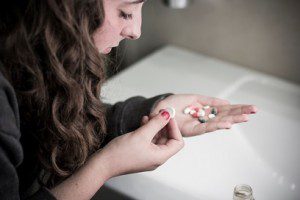College students who are dependent on prescription painkillers can be successfully treated with buprenorphine/naloxone or sustained-release naltrexone, according to experts.
Some college students misuse their own prescriptions, while others go “doctor shopping” to obtain multiple prescriptions, obtain prescription drugs from friends or buy them from dealers, according to Staff Psychiatrist Joshua Hersh, MD of Miami University in Oxford, Ohio. “They may be mixing drugs in a dangerous combination, or using higher doses of their own medication, which facilitates addiction,” he says.
When Dr. Hersh treats students for prescription drug abuse, he has them sign a release form that allows him to speak with their treating doctor and pharmacist. “If there is an issue with misusing a drug, I can communicate with their treatment providers about concerns I have,” he says. He also checks the Ohio prescription drug monitoring database, to see where students are getting their medication. If the student is from out of state, he can’t always check. Ohio’s database works in conjunction with some states, but not others.
He tries to treat students on an outpatient basis whenever possible. “If they need inpatient care, it costs more, and they have to withdraw from school, so all the work they have done up until that point in the semester is gone. They have to retake the classes when they return,” Dr. Hersh says. Once they return to campus, they often return to the same friends who used drugs with them, making recovery difficult.
Outpatient treatment, while allowing students to stay in school, keeps them in the same environment that got them into trouble in the first place. “They’re around the same people they were using with, so they have to learn to create a new environment, with new housing and friends,” Hersh notes.
At Miami University, buprenorphine/naloxone (sold as Suboxone) has been administered to students by a school nurse to prevent diversion, Dr. Hersh says. The medication is infused into strips that are placed under the tongue.
A study published in 2012 by researchers at Temple University in Philadelphia found opioid-dependent university students can be safely and effectively treated with buprenorphine in a university counseling center. The students were being treated for heroin or prescription opioid use. Lead researcher Peter DeMaria, Jr., MD, noted some students continue to use marijuana while being treated, which presents a challenge.
Since college students are young, those who have become addicted to opioids usually have not been using them for a long time, says Dr. DeMaria, Clinical Professor in the Department of Psychiatry and Behavioral Sciences at Temple University School of Medicine. “The good news is we can intervene early in their addiction. The challenge is their level of denial is higher, and their willingness to connect with services is less,” he says. “Sometimes they’ll use buprenorphine for awhile and they think the problem is cured, and they don’t want to continue treatment. They don’t want to go to counseling or 12-step meetings.”
Dr. Hersh prefers treating students with sustained-release naltrexone (Vivitrol), which is given as a once-monthly shot. “If we can put students on sustained-release naltrexone, we don’t have to worry about diversion and having to taper them off. With naltrexone, you can just stop treatment when the student is ready.”
Naltrexone works by blocking opioid receptors in the brain, without activating them, therefore blocking the effects of opioids. Buprenorphine partially blocks the effects of opioids, so that they produce less of an effect than a full opioid when they attach to an opioid receptor. When a person takes a partial opioid such as buprenorphine, they may feel a very slight pleasurable sensation, but most people say they just feel normal or more energized.
College students being treated for opioid dependence on campus can’t completely change the people they are exposed to, so they are at risk of falling back into harmful drug use patterns, Dr. Hersh notes. “When they’re on naltrexone, they know they can’t get high, since the drug blocks opiate receptors. It’s like a shield around them that prevents them from engaging in opiate abuse.” A disadvantage to naltrexone, he pointed out, is a person using the drug has to detox from opioids about a week before they can start treatment.
Not all college counseling centers provide opioid addiction treatment, but they can refer students to doctors in the area who can help them, says Dr. Hersh. He urges all colleges to provide their safety officers with naloxone nasal spray, known as Narcan, to reverse overdoses of opioids, including prescription painkillers and heroin. “It’s important for college campuses to have as prescription drug abuse becomes more prevalent,” he says.
